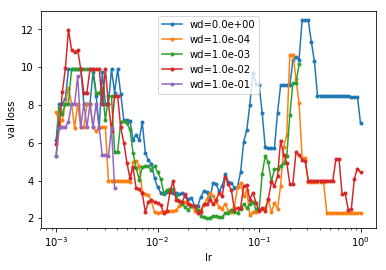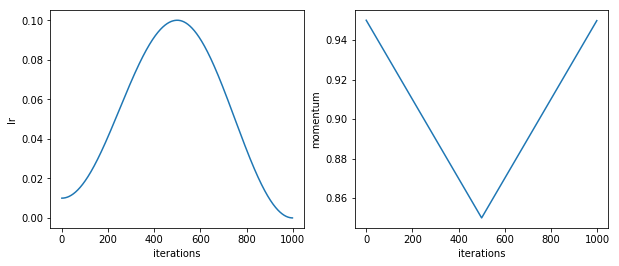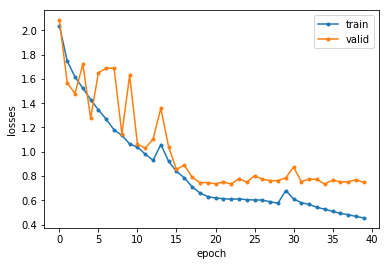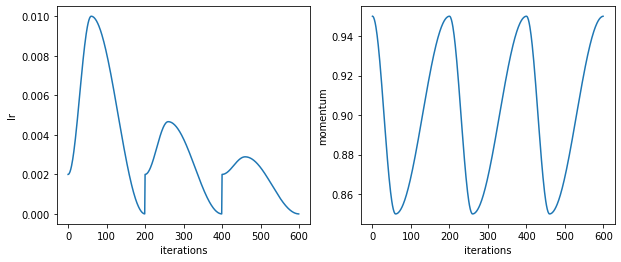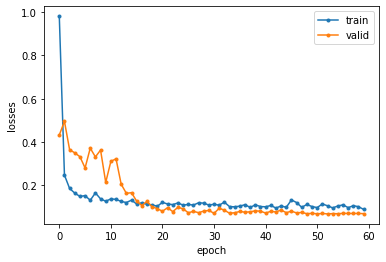This module provides Keras callbacks to implement in training the following:
- One cycle policy (OCP)
- Cyclic learning rate (CLR)
- Learning rate range test (LrRT)
(Documentation at https://psklight.github.io/keras_one_cycle_clr/)
- Learning rate & Weight decay range test.
- Using callbacks, the module works for datasets of numpy arrays or data generator.
- Common usage as callbacks for both
model.fitandmodel.fit_generatorwhereepochsis intuitively interpreted as cycle lengths.
This is inspired by how well fastai library implements this for PyTorch. By the time this module was made, a few options to implement these learning policies in Keras have two limitations: (1) They might not work with data generator; (2) They might need a different way to train (rather than passing a policy as a callback). This module addresses both limitation by defining these training policies as Keras callbacks in such a way that both model.fit and model.fit_generator can be called. For OPC, the number of epochs (argument for fitting) directly represents a cycle length. For LrRT and CLR, epochs necessary to complete a training with a particular policy can be calculated from the policy callback's .find_n_epoch.
Additionally, the utils submodule defines some useful functions such as:
plot_from_historyplots train and validation loss (if any) as a function of epochs.concatenate_historyconcatenates training and validation losses and metrics from a list ofkeras.callbacks.Historywhich can be obtained frommodel.historyafter training. This is helpful in connecting histories from multiple one-cycle policy trainings.
tensorflow- (optional)
keras matplotlib,numpy,pandas,tqdm- (optional)
numba
lrrt_cb = clr.LrRangeTest(lr_range=(1e-3, 1),
wd_list=[0, 1e-4, 1e-3, 1e-2, 1e-1], # grid test for weight decay
steps=steps,
batches_per_step=b,
validation_data=(x_test, y_test), # good to find weight decay
batches_per_val=5,
threshold_multiplier=5.,
verbose=False)
n_epoch = lrrt_cb.find_n_epoch(train_gen)
# n_epoch = lrrt_cb.find_n_epoch(x_train, batch_size) # for numpy array as train set
model.fit_generator(generator=train_gen,
epochs=n_epoch,
verbose=0,
callbacks=[lrrt_cb])
lrrt_cb.plot()ocp_1_cb = clr.OneCycle(lr_range=(0.01, 0.1),
momentum_range=(0.95, 0.85),
reset_on_train_begin=True,
record_frq=10)
ocp_cb.test_run(1000) # plot out values of learning rate and momentum as a function of iteration (batch). 1000 is just for plotting. The actual iteration will be computed when model.fit or model.fit_generator is run.# setting ``epochs`` to 20 means a cycle length is 20 epochs.
hist1 = model_kr.fit_generator(generator=train_gen,
epochs=20,
validation_data=val_gen,
callbacks=[ocp_1_cb, checkpoint, tensorboard_cb],
verbose=2)
# train for another cycle
ocp_2_cb = clr.OneCycle(lr_range=(0.001, 0.01),
momentum_range=(0.95, 0.85),
reset_on_train_begin=True,
record_frq=10)
hist2 = model_kr.fit_generator(generator=train_gen,
epochs=20,
validation_data=val_gen,
callbacks=[ocp_2_cb, checkpoint, tensorboard_cb],
verbose=2)
hist_all = concatenate_history([hist1, hist2], reindex_epoch=True)
plot_from_history(hist_all) # plot train and validation losses versus epochsclr_cb = ktool.CLR(cyc=3,
lr_range=(1e-2/5, 1e-2),
momentum_range=(0.95, 0.85),
verbose=False,
amplitude_fn=lambda x: np.power(1.0/3, x))
clr_cb.test_run(600) # see that a new cycle starts at 0th, 200th, and 400th iteration.clr_hist = model.fit(x_train, y_train,
epochs=60,
validation_data=(x_test, y_test),
verbose=2,
callbacks=[clr_cb])
plot_from_history(clr_hist)